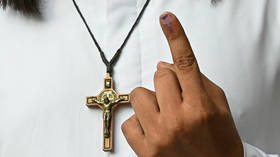Indian election enters fourth phase with turnout in focus

The fourth round of voting in the Indian parliamentary election kicked off in nine states and one union territory on Monday. The world’s largest election, which will determine India’s next government and prime minister, is being held in seven phases before the results are declared on June 4.
Notably, elections are being held in the Jammu and Kashmir union territory for the first time since 2019. During that year, the federal government stripped the conflict-torn region of its special status and statehood. Polling will be held in Srinagar, one of the two Lower House (Lok Sabha) seats in the region. Polling for the other seat, Anantnag-Rajouri, will be held on May 25.
Among the other states where people are casting their votes on Monday are Telangana, Andhra Pradesh, Bihar, Jharkhand, Odisha, and West Bengal. Overall, 96 seats are at stake during the fourth phase. Incidents of violence at the polling stations have been reported in few states.
❗️YSRCP MLA SLAPS Voter At Polling Booth In Reported Queue Clash The affronted voter returned with a slap of his own before he was reportedly beaten up by Sivakumar’s followers.📹 @YunusLasaniapic.twitter.com/4mXtQnJHX1
— RT_India (@RT_India_news) May 13, 2024
The latest round of polling is being held amid concerns over low turnout. Voter numbers for May 7, the third polling phase, were recorded at 64.4% in 93 constituencies across 11 states and union territories, which is a 2.9% dip compared to 2019 polls in the same constituencies, Indian Express noted. Lower turnout was also registered during the first two phases, according to data from the Election Commission of India (ECI).
An ongoing heatwave and “fatigue” among urban voters have been cited as possible reasons for the dip, according to experts and analysts quoted by Indian media. The India Meteorological Department (IMD) earlier warned that prolonger heatwaves – lasting 10 to 20 days, unlike the usual four to eight days – are expected between April and June.
As voting got underway, Prime Minister Narendra Modi encouraged the population to take to the polls. “Come, let’s all do our duty and strengthen our democracy,” he appealed on X (formerly Twitter). The ruling Bharatiya Janata Party (BJP) is widely favored to win the election, according to pre-voting polls.
The BJP is being challenged by the Indian National Developmental Inclusive Alliance (INDIA), spearheaded by the Indian National Congress party. The Congress’s de-facto leader, Rahul Gandhi, on Monday also called on people to vote. “Remember, your one vote will not only protect your democratic rights but will also change the fate of your entire family,” he wrote on X. “Come out in large numbers and vote and show that the country will now vote on its issues – it will not get distracted.”
Almost 970 million Indians are eligible to vote to elect 543 members of the Lower House. The next phase of polling will be held on May 20.
Where India Meets Russia – We are now on WhatsApp! Follow and share RT India in English and in Hindi













